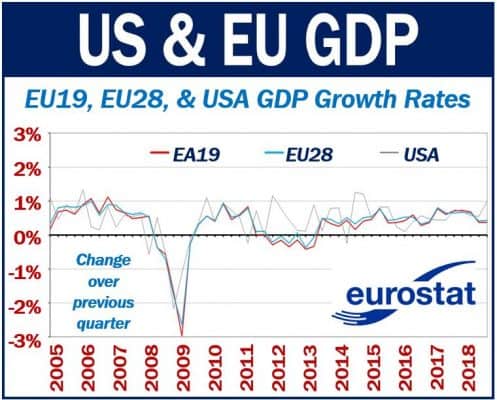EU GDP grew by 0.4% in the second quarter of 2018, according to a Eurostat flash estimate. Eurostat is the EU’s statistical office. GDP growth figures in both the euro area and the EU28 were identical, i.e., 0.4% in either region.
EU GDP also grew by 0.4% in the first quarter, with both the euro area and EU28 reporting identical growth figures.
EU28 vs. euro area (EA19)
EU28 stands for the twenty-eight EU (European Union) member states. The euro area or EA19 includes just the EU countries that adopted the euro as their national currency.
Germany abandoned the German mark and adopted the euro. Therefore, German is one of the EA19 countries.
The UK and Denmark, for example, are EU member states but have their own currencies. They are part of the EU28, but not the EA19.

EU GDP 2018 vs. 2017
EU GDP grew by a seasonally adjusted 2.2% compared to the same quarter in 2017.
The 2.2% figure applies to both the EU28 and EA19 nations.
It grew by 2.5% and 2.4% in the first quarter compared to Q1 2017 in the euro area and EU28 respectively.
GDP growth in the USA
GDP in the United States grew by 1% in the second quarter of 2018 compared to Q1 2018. In the first quarter of this year, US GDP grew by 0.5%.
US GDP in Q2 2018 grew by 2.8% compared to Q2 2017 (after 2.6% in the previous quarter).
What is GDP?
GDP stands for Gross Domestic Product. It is probably the most important economic measure of the state of a country’s economy.
With just one GDP figure, we can tell whether the economy has changed compared to a past. time.
Net value of everything we produce
GDP is the net value of all products and services that a country produces during a specific period. This total includes all taxes and subsidies.
In other words, it is the sum of all economic activity in an economy over a specific period.
There are three ways we can calculate GDP: 1. Output. 2. Expenditure. 3. Income.

